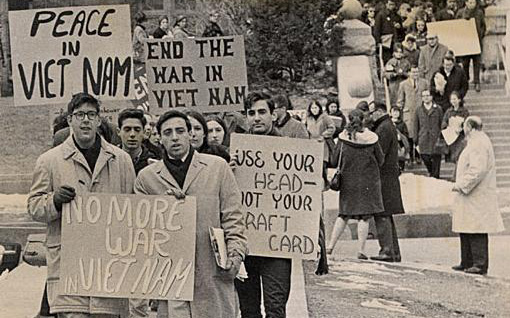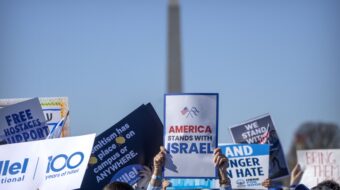
Nationwide demonstrations staged by the student-run National Coordinating Committee to End the War in Vietnam took place on this date 50 years ago in 1965. These actions drew 100,000 people in 40 cities across the country, following the first public demonstration in the nation’s capital on April 17 of that year, sponsored by Students for a Democratic Society.
Young men, beginning as early as May 1964, were already burning their draft cards at anti-war rallies and demonstrations. By May 1965 it was happening with greater frequency. In response, in August 1965, Congress enacted a law to broaden draft card violations to punish anyone who “knowingly destroys, knowingly mutilates” his draft card.
On Oct. 15, 1965, the first public burning of a draft card in direct violation of that law took place in New York City, when David Miller, 24, a Catholic pacifist affiliated with the Catholic Worker movement, attended a rally held near the Armed Forces Induction Center on Whitehall Street in Manhattan. He spoke briefly to the crowd from atop a sound truck and then tried but failed to burn his card with matches – the wind kept blowing them out. A lighter was offered from the crowd and it worked. FBI agents later arrested him; he was tried, found guilty, and sentenced to two years imprisonment.
Draftcard burning was a symbol of protest performed by an estimated 25,000 young American men as part of the opposition to U.S. involvement in the Vietnam War. October 16, 1967, was a day of widespread war protest organized by The Mobe in 30 cities across the U.S., with some 1,400 draft cards burned.
During the Vietnam War years from 1965 to 1973, dozens of men were indicted for burning their draft cards at public rallies, and four major court cases were heard. One of them, United States v. O’Brien, was argued before the Supreme Court on the grounds of free speech, a constitutional right guaranteed by the First Amendment. The Supreme Court decided against the draft card burners; it determined that the federal law was justified and that it was unrelated to the freedom of speech, an outcome that was criticized by legal experts.
Yet comparatively very few men in the U.S. were convicted of this crime. Most went unpunished.The image of draft card burning was a powerful one, influential in American politics and culture.It appeared in magazines, newspapers and on television, signaling a political divide between those who backed the government and its military goals and those who were against the war and against forcing young people into serving a mission with which they had profound moral and political disagreement.In 1968 on Broadway and in London’s West End, the musical “Hair” featured a climactic scene in Act I of a group of men in a hippie “tribe” burning their draft cards while the main character Claude struggles with the decision to join them.
Turn in, tune out
About 1000 draft cards were turned into Selective Service boards and other government offices on April 3, 1968, in nationwide protests organized by The Mobe. In Boston, 15,000 protesters watched as 235 men turned in their draft cards. Since few of the draft card burners had actually been apprehended, war protesters were increasingly choosing the more profound act of turning in their draft cards, an act which gave the government the name and address of the protester. Burning the draft card destroyed the evidence, which by this time was seen as less courageous.
The moral rectitude of these protestors stands in sharp contrast to the attitude of others who also did not want to serve in the military, but for purely personal reasons. Later Vice President Dick Cheney defended himself, saying he had “other priorities” at the time. Cheney is but one of a very long list of those who have come to be known as “chicken hawks” – militarists eager to send other people’s children off to war, potential death or permanent disability, without themselves having served when given the opportunity.
Young people today have little idea what wrenching decisions roiled within a young man’s heart while the draft was still an unavoidable factor in his life. Thousands of people left the country permanently for that reason.
Ironically, Richard Nixon ran for president in 1968 on a platform based partly on putting an end to the draft, in order to undercut protesters making use of the symbolic act, and undermine the whole anti-war movement, which was largely student-based. He determined that he could gain supporters on both sides of the war question by promising to make the military into a purely volunteer force. After gaining the presidency – twice, in 1968 and 1972 – Nixon finally stopped the draft after February 1973. The last man to be drafted entered the U.S. Army on June 30, 1973.
By that time the war had been “Vietnamized,” with remaining U.S. troops serving in a more advisory capacity to the corrupt South Vietnamese government. The war ended when that government fell at the end of April 1975.
Adapted from history.com, Wikipedia, and other sources.
Photo: Wikipedia (CC)

MOST POPULAR TODAY


Zionist organizations leading campaign to stop ceasefire resolutions in D.C. area

Communist Karol Cariola elected president of Chile’s legislature

Afghanistan’s socialist years: The promising future killed off by U.S. imperialism

High Court essentially bans demonstrations, freedom of assembly in Deep South






Comments